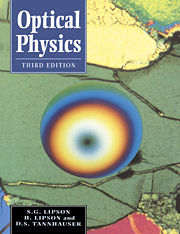Book contents
- Frontmatter
- Contents
- Preface to the third edition
- Preface to the second edition
- Preface to the first edition
- 1 History of ideas
- 2 Waves
- 3 Geometrical optics
- 4 Fourier theory
- 5 Electromagnetic waves
- 6 Polarization and anisotropic media
- 7 Diffraction
- 8 Fraunhofer diffraction and interference
- 9 Interferometry
- 10 Optical waveguides and modulated media
- 11 Coherence
- 12 Image formation
- 13 The classical theory of dispersion
- 14 Quantum optics and lasers
- 15 Problems
- Appendix 1 Bessel functions in wave optics
- Appendix 2 Lecture demonstrations in Fourier optics
- Bibliography
- Index
Appendix 2 - Lecture demonstrations in Fourier optics
- Frontmatter
- Contents
- Preface to the third edition
- Preface to the second edition
- Preface to the first edition
- 1 History of ideas
- 2 Waves
- 3 Geometrical optics
- 4 Fourier theory
- 5 Electromagnetic waves
- 6 Polarization and anisotropic media
- 7 Diffraction
- 8 Fraunhofer diffraction and interference
- 9 Interferometry
- 10 Optical waveguides and modulated media
- 11 Coherence
- 12 Image formation
- 13 The classical theory of dispersion
- 14 Quantum optics and lasers
- 15 Problems
- Appendix 1 Bessel functions in wave optics
- Appendix 2 Lecture demonstrations in Fourier optics
- Bibliography
- Index
Summary
Introduction
Optics is the ideal subject for lecture demonstrations. Not only is the output of an optical experiment usually visible (and today, with the aid of closed circuit television, can be made visible to large audiences), but often the type of idea which is being put across can be made clear pictorially, without measurement and analysis being required. Recently, several institutes have cashed in on this, and offer for sale video films of optical experiments carried out under ideal conditions, done with equipment considerably better than that available to the average lecturer. Although such films have some place in the lecture room, we firmly believe that the student learns far more from seeing real experiments carried out by a live lecturer, with whom he can interact personally, and from whom he can sense the difficulty and limitations of what may otherwise seem to be trivial experiments. Even the lecturer's failure in a demonstration, followed by advice and help from his audience which result in ultimate success, is bound to imprint on the student's memory far more than any video film can do.
The purpose of this appendix is to transmit a few ideas which we have, ourselves, found particularly valuable in demostrating the material covered in this book, and can be prepared with relatively cheap and easily-available equipment. Many other ideas are given by Taylor (1988). Need we say that we also enjoyed developing and performing these experiments?
- Type
- Chapter
- Information
- Optical Physics , pp. 469 - 475Publisher: Cambridge University PressPrint publication year: 1995



